
MAY CONTAIN NUTS

Search Shorpy
SHORPY ART

Framed or unframed, desk size to sofa size, printed by us in Arizona and Alabama since 2007. Explore now.
Join and Share
Ad-Free Shorpy
Shorpy is funded by you. Patreon contributors get an ad-free experience.
Learn more.

Recent comments
- Button It Up
- And with an eye on the time ...
- Working in an enclosed ashtray
- Rear View Mirror?
- Tobacco cam
- Basic fact I learned only later in life
- Put a Lid on it!
- Pinstripes in the Tower
- Sound enhancement
- 3438 in '38
- Second Career
- Their days are numbered
- Only the Sensor
- Train control mechanism
- Rarest of the Rare?? & Classy 3400 Class
- Control Mechanism
- Those standpipes
- Wrenches
- International D-40 I believe
- Job prospects
- You had me at Train
- Land of the free
- Broad-Exchange Bldg
- Parking innovation
- The old block
- "Peck turned a sweet propeller"
- National Bank Building
- Notch shot
- Straight ahead (right, left, left, right)
- Ship lifespans
Member Photos
The Shorpy
Printporium
Printporium
Search Shorpy
Search results -- 30 results per page
- Taking the Air: 1924
- ... glass negative. View full size.
Munford in 1931 Night Club Tragedy On May 16, 1931 the young woman on the right accompanied a young man, Robert Montgomery, to a night club, and later that night Montgomery killed a police officer.
(The ... Posted by Dave - 09/13/2016 - 12:18am -
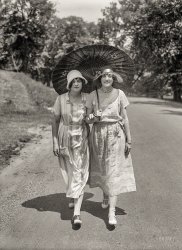
- Modern Medicine: 1924
- ... that nurse was there, though, who'd care?
Heavy-duty night shirt Rather bulky compared with today's "robes" that one wears in the ... Posted by Dave - 05/14/2020 - 1:08pm -
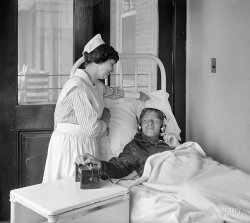
- ColumBus: 1943
- ... Pennsy during the golden age of steam.
It Happened One Night See this Yellow Coach in the Oscar winning 1934 film It Happened One Night with Clark Gable, Claudette Colbert, Ward Bond.
Break out the Bubley ... Posted by Dave - 09/07/2014 - 5:21pm -
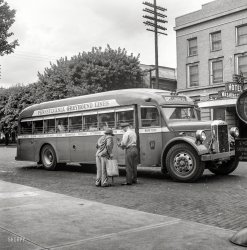
- Feeding Station: 1942
- ... wriggles his tail as he sends up a spark.
He pierces the night with his one yellow eye,
And all the earth trembles when he rushes by. ... Posted by Dave - 03/11/2024 - 11:06am -
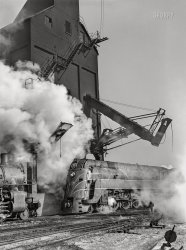
- Ladies' Furnishings: 1951
- ... The store is brand-new. -Dave]
Where is the night watchman? Comfy looking man cave, football-watching furniture, ... Posted by Dave - 01/22/2015 - 1:45pm -
![Ladies' Furnishings: 1951 May 17, 1951. "John Wanamaker, Great Neck, Long Island. Staircase I." Two departments of this New York department store; we wonder if Alice and Trixie ever ventured out this far. 4x5 negative by Gottscho-Schleisner. View full size.
Hoity-toity!Somehow I think John Wanamaker would have been out of Ralph Kramden's price range, and Ed Norton's, too.
OK, OK,Why is the handrail wrapped in cloth?
[To keep it from getting dinged or scratched. The store is brand-new. -Dave]
Where is the night watchman?Comfy looking man cave, football-watching furniture, pre-opening day for the store given the paper wrapping on the handrails and void of human activity, or maybe it's just "shorply" after 6 AM.
Re: Hoity toityHaving grown up nearby, even if Alice & Trixie had had the means, they probably wouldn't have made it across the parking lot before being caught by the locals -- no doubt by a group of "ladies who lunch" that could spot someone from the city and cut them dead at 100 yards...
In regards to the stairway treatment; the panels on the railing closely resemble some sheers we had in our living room -- "flameproof" Fiberglas fabric. Lasted forever, but don't EVER put them in the wash -- worse than itching powder.
Before self-serviceThis was a very elegant, plush and classy environment in which to shop without the frantic pace and chaos of lining up at checkout counters, when a salesperson would leisurely show you what was available, find your size, attend to your needs and check with the stockroom to see if they had exactly what you wanted. Sometimes there was a live piano player on the main floor and the carpeting kept the noise level soft, peaceful and quiet. I am curious about the item that looks like a miniature female mannequin in a hooded raincoat on the extreme left counter of this picture near the hats and accessories. I bet that little novelty would be a collectible today and I think it would have been a pleasure to shop here.
[That's a nice evocation of the old-school department store. There were of course plenty of self-service retail establishments going back to the early years of the 20th century, and I suspect Wanamaker's, with its racks of suiting and shelves of shirts, had the about same degree of self-service as its modern analogues. What it isn't is a high-volume discount chain like Walmart or Target. - Dave]
Yes Dave, you are correct. One store that is old and probably out of business stands out in my mind as basically just racks and racks of clothing in huge warehouse-like buildings and that would be the old Robert Hall stores, but they did have bargains in apparel. I don't think they sold much other than suits, coats, jackets and things of that ilk. It really was "off the rack" merchandise in every sense of the word.
The day after the store openedAnd less than four years before it closed. Story here.
Mini mannequin I have a very dim memory of such mannequins being used to display miniature foundation garments in the 1950s, presumably in the interests of modesty.
Childhood memories.My mother used to shop at this store. Those elevators were manned by uniformed operators ready to transport you to any of the three floors. After Wanamaker left it became Gertz for many years until the seventies.
Hot Copper BottomsLooking down the stairs, to the right, is a sales gondola of RevereWare copper bottom saucepans with lids. I wish we could read the pricing panel at the top of the gondola. My grandmother prized her RevereWare and the copper was always bright and polished. I still use much of her collection, over 60 years old.
(The Gallery, Gottscho-Schleisner, Stores & Markets)](https://www.shorpy.com/files/images/SHORPY-5a20480u.thumbnail.jpg)
- While the City Sleeps: 1940
- Fall 1940. "New Bedford, Massachusetts. Foggy night." Another noirish image from the prolific Jack Delano. Medium format ... negative. View full size.
A dark and stormy night One expects to see Joe Friday step out of the shadows.
Ward 3 I ... Posted by Dave - 10/23/2013 - 9:38am -
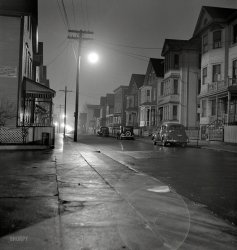
- Body by Fisher: 1940
- ... A guy could get arrested hauling bodies in that trunk.
Night Light Here's one of those photos you were looking for, ... Posted by Dave - 03/29/2015 - 1:22pm -
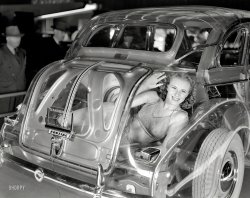
- Hill Street: 1942
- ... Below is the same view from April of 2011.
Lady for a Night With John Wayne and Joan Blondell.
Dual Gauge Track The ... Posted by Dave - 03/23/2014 - 2:17pm -
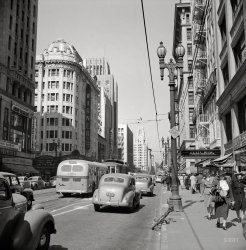
- Down to the River: 1923
- ... thought so, too!
Bathing by Day, Sleeping by Night An elderly neighbor of mine in the 1300 blk of Maryland Ave NE, born ... Posted by Dave - 08/05/2012 - 5:08pm -
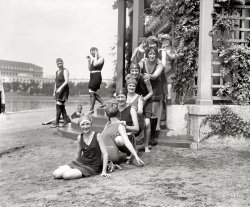
- Easy Women: 1920
- ... rage describes it as well or better anyway.
"Night losses" I was unfamiliar with the term, so I googled. Came across ... Posted by Dave - 09/13/2011 - 9:59pm -
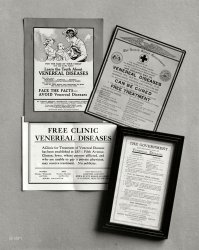
- Uray for Hollywood: 1940
- ... is the only Mesker non-survivor.
Through dark of night It appears that the theatre is gone and in its place, a small post ... Posted by Dave - 11/06/2018 - 8:01pm -
![Uray for Hollywood: 1940 September 1940. "Theater in Ouray, Colorado." Now playing: "Primrose Path" with Ginger Rogers and Joel McCrea. Photo by Russell Lee. View full size.
Gone todayThese ornate facades were made by two competing family companies, the Mesker Brothers Iron Works of St. Louis or George L. Mesker & Co. of Evansville, Indiana. Ouray had 15 such buildings. The Hiebler building is the only Mesker non-survivor.
Through dark of nightIt appears that the theatre is gone and in its place, a small post office. If you look at the mountains behind, they fit the configuration of the one in the above picture of the Uray. BTW, it was named after Chief Uray; I don't know when or why they added the "O".
[His name is generally spelled Ouray, although one is just as arbitrary as the other, devised as it was by users of the Roman alphabet. - Dave]
He/she is baaack!One of the coming attractions advertised is "Too Many Husbands," a Columbia Pictures comedy staring Jean Arthur as a wife whose first husband is supposedly lost in a shipwreck, only to return after she remarries. A couple of months later, RKO released "My Favorite Wife," a comedy staring Cary Grant as a husband whose first wife is supposedly lost in a shipwreck, only to return after he remarries.
Nearly every one of the silver-rush-era buildings on Main Street in Ouray with cast-iron facades has been preserved. This building, sadly, is the exception.
What a facade!From https://www.boxcanyonouray.com/ouray-heritage/history-of-ouray-the-meske...
For profit-minded businessmen in the late 1800’s the goal was to stand out from the crowd. For those who couldn’t afford fancy masonry or cast iron embellishments, there was an alternative: pick up a catalogue and order a decorative, galvanized sheet metal facade from the Mesker Brothers Iron Works or George L. Mesker & Co. Purchasers could pick and choose from a range of cast iron and pressed metal mass-produced components or spring for a lavish top-to-bottom facade. Their order would come in by train and in just a few days, a plain brick or wood box of a building could be transformed into a beautifully elegant edifice, at roughly one-fifth the cost of a masonry facade.
Moved across the street since 1940?And partially modified on the ground floor entrance? If so, the "Uray Theatre" is still standing.
"Cinema Treasures" (http://cinematreasures.org/theaters/28411) incorrectly lists the former Uray Theatre was located at the site of the historic Wright Opera House (southwest corner of Main and 5th), whose dimensions and facade look nothing like the above.
BUT, using Google Earth at street level, going half a click north of the Main & 5th on the east side of the street just after the Beaumont Hotel is an identical building to the Uray Theatre - same facade and ornamentation (sans triangular structure on the cornice up top and "James" in place of "18HEIBLER89"), only the ground entrance modified. Take a look at the street view - looks like the same building, just moved across the street sometime after 1940:
[The Uray Theatre was at 624 Main Street. The building seen below is next to the Beaumont Hotel at 515 Main -- two entirely different structures. As noted in the other comments, there are over a dozen buildings in Ouray with similar facades. - Dave]
14 out of 15 ain't badExcept for this building. The article linked by FixIt says that of the 15 Mesker façades installed in Ouray, 14 still remain. The exception: the Hiebler building at 624 Main St.
Murder and Suicide Startles CityNews clipping about the Hiebler family in Ouray. Click for the rest of the story.
(The Gallery, Movies, Russell Lee, Small Towns)](https://www.shorpy.com/files/images/SHORPY-8b26234a1.thumbnail.jpg)
- Oke Doke: 1939
- ... or a "Honky Tonk". A rose by any other name.
"Night Club..." Seems a little grand: try "road house."
Cook's ... Posted by Dave - 03/16/2014 - 12:59pm -
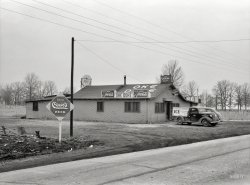
- Bloomer Girl: 1918
- ... quite
the trailblazers we thought.
"Lots of night games" Wasn't that the recommendation?
Storage Space One ... Posted by Dave - 12/29/2014 - 11:52am -
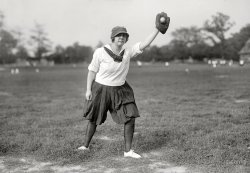
- Figure Studies: 1942
- ... remember ... but, don't ask me what I ate for dinner last night.
Yes, gypsum lath ... I put up a lot of it for plaster walls in ... Posted by Dave - 02/27/2024 - 12:50pm -
![Figure Studies: 1942 April 1942. "Madison, Wisconsin. Members of the University of Wisconsin's Blue Shield Country Life Club visiting the studio of John Steuart Curry, university artist-in-residence. One of the aims of the club is to bring about greater participation in cultural activities among farm people." Acetate negative by Jack Delano, U.S. Foreign Information Service. View full size.
Elephant in the room --I am chuckling at the posters' varied comments on drywall -- drywall?
For pity's sake fellows, there are *naked people* on the walls.
Fair EnoughI am interested in the large work on the wall above them. Anyone know what that is? Might it be a Curry? Ah, yes it is "State Fair," and in color!
Cultural RiftFarm life is a culture in itself. These days, the trend of modern homesteading, farm B&B experiences, the resurgence of vegetable gardening, and food preservation is often portrayed as aspirational - absurdly glossy and sometimes morally superior, which I find ridiculous.
Thinking of my two sets of grandparents, all farmers in the Midwest from the 19-teens to the 1960s, and first-generation Americans, my mother's family was very much immersed in the cultural offerings available to them, while my father's side was deeply superstitious and suspicious of "outsiders." Both sides had their good qualities and flaws, but the difference in "worldliness" between these families who were in like occupations, of similar economic status, and living in the same general area is marked. How much or how little the two families embraced broader cultural experiences is vastly different.
My mother's immediate and extended family was very well read, made trips to museums and concerts, and attended lectures when they could, were involved in local civic organizations and school boards, had leadership roles in agricultural and conservation organizations, and their churches. There was a desire to acquire new skills, and to modernize the farm. They hosted foreign students who were attending a local university in the 1940s and '50s, and maintained correspondence with those students for decades after.
Conversely, my father's family, who we lived closer to, was quite insular. Any unfamiliar vehicle that came down the road was the topic of endless speculation, and even unease. They gossiped with glee, and could fire up the righteous indignation at the drop of a hat. They did possess some musical talent, but it was not shared beyond the family or church. Oddly, no one offered to teach us grandkids guitar or piano, nor invited us to sing - we were watchers only. We grandkids did learn a bit about raising animals, gardening, and preserving food, but the methods were static, stuck in a former era. Agricultural practices were never updated. Unsurprisingly, no one took up farming, and the land was leased to other farmers after my grandparents retired.
From the days before the drywall we know todayThose small rectangular sheets, often generically referred to as "sheetrock" (after the United States Gypsum Company trademarked brand Sheetrock) were commonly used before the advent of the standard, larger sheets in later years.
A variation of this product was one of similar size called rock lath and was used in cases where a plaster coat was desired. This had perforations to allow the plaster to form "keys" in the same manner as in older construction that relied on the use of wood lath strips with spaces in between to receive the wet plaster. When dried, the plaster would be locked in place where it had been pressed through the strips.
Deja vu Agri CultureI thought this group and setting looked familiar. Sometimes, I'm amazed by what I remember ... but, don't ask me what I ate for dinner last night.
Yes, gypsum lath ...I put up a lot of it for plaster walls in the 1950s and '60s. It was a simple job that a kid could do without consequential mistakes. Our lath was solid (non-perforated) but held the plaster well, probably because the outer layer of paper was fuzzy. I know it worked because the plaster walls in one house I prepped are still in fine condition after 62 years.
The lath sheets were 18x48 inches and fit well with studs on either 16- or 24-inch centers. Wall studs in the pictured room are on more expensive 16-inch centers as indicated by the nail spacing. The walls were probably always intended to be tack boards and never finished with plaster, which would have been done before the window trim was applied.
Drywall sheets came later, had a smooth finish for painting, were thicker, and of course were typically 4x8 feet. The plastering trade gradually disappeared after the innovation of drywall, and with it the fine decorative finishes that one sometimes can find in old houses. Plaster was more expensive and took a long time to dry, which held up the construction process.
ElephantsSince it's in an artist's studio, it is "art". Otherwise it would be smut.
Was the photo edited?If you look at the right hand of the woman seated in this photo - and in the one another commenter linked to - it appears that she was smoking a cigarette, but that the offensive object was photo-shopped out of the image at some point. Which does raise a question as to whether the artwork was edited too.
[Um, no. And no. - Dave]
(The Gallery, Education, Schools, Jack Delano)](https://www.shorpy.com/files/images/SHORPY-8d03516a.thumbnail.jpg)
- Soldiers Joy: 1940
- ... by Marion Post Wolcott. View full size.
The Night was Moist Oh, I see! It's the name of the café. I thought the ... Posted by Dave - 08/05/2020 - 2:23pm -
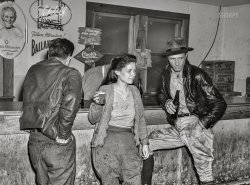
- So You Want to Get Married
- ... Henie on the cover of Popular Photography!
"Night Must End" Pretty well-known in her day, Margaret Price was an ... slightly used Spaniards for one good Irish-American any night in the week. I feel sorry for the women of Cuba. Theirs not to reason ... Posted by Dave - 10/17/2013 - 12:49pm -
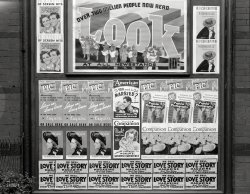
- Cothouse: 1942
- ... episode "The Ghost Wolf," Clark, Lois and Jimmy spend the night in one of these dorms. The place is so enormous that Lois doesn't think ... staying in one end while her two colleagues spend the night in the other.
2 in '42? BTW the Cincinnati Enquirer described ... Posted by Dave - 01/18/2024 - 1:39pm -
![Cothouse: 1942 November 1942. "Oklahoma City, Oklahoma. Cot house." The California Dormitory, offering not just "clean cots," but checkers and dominoes. Acetate negative by John Vachon. View full size.
SnoringIt may be a good 80 years ago and 5500 miles away, but I can still hear the snoring .
50% PremiumI wonder what extras you got for 15 cents versus the base price of a dime. A blanket? Larger size?
Heads Carolina, Tails CaliforniaI wonder how the owners/proprietors of the Largest and Most Modern Cot House in the Southwest settled upon the name "California Dormitory" as opposed to some other state dormitory? And I'd like to see the signage on nearby culinary establishments where the denizens of the Cot House got their three hots.
“California” DormitoryIt wasn’t named for the State, but rather after its location - 308 W. California Street in OKC. That part of the street no longer exists.
“California” was also the name of that specific style of dorm construction in vogue when built. I don’t know what that was/is.
The 15-cent CotMy best guess is that they gave you a second mattress to lay over the first. I don't think a cot mattress was more than an inch thick.
BTW the sign in the window refers to E.H. Moore, who was running for Senate. He won, but his health failed him and he did not run for re-election. He died in 1950.
Spelling (sigh)"Shower Bath Privilegs" - we signpainters have a proud tradition of phonetic spelling. The workmanship is quite impressive - even some flourishing around "Free" // I wonder if this was for wartime workers needing a place, or if 'Cot House' was just a standard system during the Depression?
The California Dormitorywas a style -- huge but cheap to build -- that came into being in the 1930s during New Deal employment programs. In the Adventures of Superman episode "The Ghost Wolf," Clark, Lois and Jimmy spend the night in one of these dorms. The place is so enormous that Lois doesn't think twice about staying in one end while her two colleagues spend the night in the other.
2 in '42?BTW the Cincinnati Enquirer described "2 in '42" as a "mystery symbol." I guess it was a very good mystery, since no one today seems sure about what it meant. I've scouted around a bit, and it may have meant that people should buy two war bonds during the then-current year, 1942.
[Two days' pay. - Dave]
15 centsFree WiFi.
New Orleans CotsIn about 1960 I stayed at a Cot Dormitory for a few cold nights. The price was either 25 or 50 cents a night, I forget. You raised the head of your bed up and put your shoes under the bedpost so they wouldn't be stolen.
I hitchhiked through 37 states in that period, met a lot of good people.
50% PremiumCots were 10 cents, clean cots were 15.
(The Gallery, John Vachon, OKC)](https://www.shorpy.com/files/images/SHORPY-8d09898u.thumbnail.jpg)
- Karnak: 1858
- ... looking for "Shorpy worthy" photos tomorrow.
and at night more than 100 years later ... Posted by Dave - 11/29/2007 - 1:30am -
![Karnak: 1858 Portico at ruins of Hypostyle Hall, Temple of Karnak at Luxor, Egypt, circa 1858. View full size. Albumen print by Francis Frith.
so good, so old a pic!wow. really fantastic! way to document! what's so fascinating is the dress of the people. reminds me of that old silent movie Grass. really great image.
Wrong!The picture is not of Karnak - it's the Colonnade in Luxor Temple, with the mosque of Abu el Haggag in the background - but otherwise it's a wonderful picture.
Size!Large negative images of Egypt are the best -- you can feel the texture of the stone.
A Century & A Half Ago!1858!? Holy cow, this could just as easily have been taken in 1958! I wonder just how many pre-civil war photographs actually exist. There couldn't possibly have been very many cameras in existence at the time.
[At the very least, many thousands of photographs from the era survive as daguerreotypes, prints and glass negatives. Photography had been around for a quarter of a century in 1858. - Dave]
Egyptian PhotographsI have multiple albums of photographs from the late 1870's of a trip taken to Egypt and the surrounding areas, never have been scanned, I ought to do so, some of the pictures are amazing. All are large photographs....
scan 'em!well, get scanning, friend! (i know how time consuming to get the parameters you would want, so that's somewhat a tongue-in-cheek remark :)
Scanning For YearsThere are five books, each has about 100 photographs, so I'll be done in a few years. I will start looking for "Shorpy worthy" photos tomorrow.
and at night more than 100 years laterhttp://homepage.powerup.com.au/~ancient/lux_tem3.jpg
Wow.Over the last 150 years they've really dug those columns out! If you match up the chips/marks in the some of them, you can see that almost half of the current height was underground in 1858. Cool.
Very lovely photo.Very lovely photo.
(The Gallery, Curiosities)](https://www.shorpy.com/files/images/04546u1.thumbnail.jpg)
- Steel Noir: 1941
- ... man was truly an Artist with a capital A.
Red sky at night The sky would glow red when this mill poured slag at night. It was beautiful, if not exactly environment-friendly.
(The ... Posted by Dave - 12/12/2019 - 8:37pm -
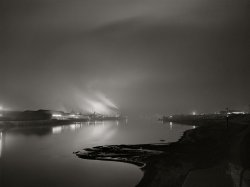
- Off Broadway: 1942
- ... waterproof overshoe over his work boots.
Sad Sunday night He makes my heart ache.
Waterproof overshoes Waterproof rubber ... Posted by Dave - 06/10/2018 - 1:35pm -
![Off Broadway: 1942 September 1942. "Batavia, New York. Elba Farm Security Administration farm labor camp. An old man who has lived all of his life near Broadway, New York City, and who was taken off relief and sent to the Elba FSA camp to work in the harvest. He said, 'There is so much suffering in the world today that mine doesn't seem so much, and I'm doing my best to help bring in Uncle Sam's crops'." 4x5 nitrate negative by John Collier for the Office of War Information. View full size.
Boo-HooeyTo those among us inclined to lament that Americans today have nothing to complain about compared to this fellow:
1. You are wrong. Homeless kids whose parents are in jail are living in cardboard boxes in the woods behind my Wal-Mart.
2. STOP YOUR WHINING.
ProtectionAfter looking closely at the laces on that right boot, I think he is wearing some sort of shiny (rubber?) waterproof overshoe over his work boots.
Sad Sunday nightHe makes my heart ache.
Waterproof overshoesWaterproof rubber overshoes are called galoshes.
Uncomfortable much?Collier seems to have posed his subject over the crack between two benches.
So much to ask but mostly:I wonder what kind of jokes made this man laugh.
Dapper DanInteresting mixture of clothing -- pinstripe suit coat, possibly bib-overalls and new work boots.
Really AnonTip? You have homeless kids living behind your local Wal Mart? Why have you not reported them to your local state's child welfare division office? We have social programs for that the last I checked to take them in and provide foster homes. So you are wrong about comparisons. Back in the days of this photo, there really WERE homeless kids in the street and no government social safety net to provide for them. Today, we have multi-billion dollar programs to take care of them.
[These kids move around, and DCS does not have to money to buy them hotel rooms, pay their rent or build them houses. I live in a small town in Arizona that has over 300 homeless students. Last year I gave $40 to two boys living in a tent behind the grocery store. Below are some links from my own local newspaper so that you may become better-informed. - Dave]
Link 1.
Link 2.
Link 3.
Link 4.
(The Gallery, Agriculture, John Collier, Portraits)](https://www.shorpy.com/files/images/SHORPY-8c34233a.thumbnail.jpg)
- Store Greeter: 1938
- ... today's travelers. Everything here qualifies.
Good night, John-Boy It could easily be Ike Godsey's general store on "The ... Posted by Dave - 11/07/2012 - 2:37pm -
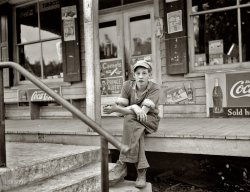
- Winter Lights: 1909
- ... made 2011 a treat, I wonder what new adventures await?
Night of Lights Wishing all who enter this wonderful website a Merry ... Posted by Dave - 08/09/2012 - 3:17pm -
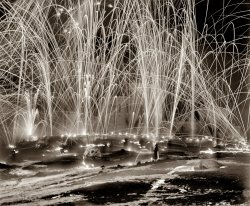
- St. Mary in the Mountains: 1966
- ... You have to like a school (and community) like that.
Night view Here it is at night, June 2015.
(ShorpyBlog, Member Gallery, tterrapix) ... Posted by tterrace - 02/11/2018 - 10:48pm -
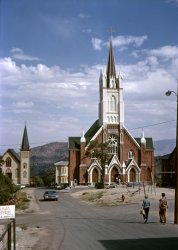
- Strangers on a Bus: 1943
- ... reminds me of the wonderful scene from It Happened One Night when all the bus passengers sing "The Man on the Flying Trapeze." It's a ... The upside is we end up somewhat ambidextrous.
The Night Porter "All the lonely people. Where do they all come from?"
... Posted by Dave - 09/11/2009 - 4:18am -
![Strangers on a Bus: 1943 September 1943. "Greyhound bus trip from Louisville, Kentucky, to Memphis, Tennessee. Passengers on the Memphis-Chattanooga bus." Medium-format nitrate negative by Esther Bubley for the Office of War Information. View full size.
That surreal qualityI notice someone's left hand holding the flash at the left side of the image ... Ms. Bubley must have enlisted a passenger to hold the flash and aim it rearwards. Either that or she had an assistant traveling with her. Either way, that's a very tight situation going on there, and sort of creates that surreal quality of contrasts. I can also imagine that she and her camera might have displaced at least two of those persons standing in the aisle? Not a natural-looking scene!
[Esther seems to have made frequent use of floodlights and assistants. - Dave]
TypesWe've got a wonderful array of character types here: a sailor, a maiden aunt, a housewife, some businessmen, an elderly gentleman farmer, and people snoring comfortably in the back. This reminds me of the wonderful scene from It Happened One Night when all the bus passengers sing "The Man on the Flying Trapeze." It's a real slice of life, and I absolutely love this picture.
Ellen!Grandma Walton has a front row seat.
Alfred Hitchcock Presents"South by Southwest."
Act 1It really looks like the promotional still for a movie.
Talk about life imitating art.
DiscomfitureI don't know who's more distressed, the sailor or the woman sitting next to him.
[They're in different rows. - Dave]
Cast of CharactersThis is a very disturbing photo. Very Hitchcock or Twilight Zone.
SouthpawReversed negative or the dude in the vest has a left handed belt.
[So where would s Southpaw go to buy a "left-handed belt"? - Dave]
Re: "Southpaw" Time for one of your quarters, Dave...
[Done. - Dave]
Left-handed belt storeGot him on that one. But, as a bonafide left-hander, I can say the issue does arise when you have been given a belt with a buckle which has an inscription on it. Although when the writing is upside down, I can read it a lot more easily. Yet this trivial belt direction humor does show we left-handers learn quickly to adapt to a right-hand world. The upside is we end up somewhat ambidextrous.
The Night Porter"All the lonely people. Where do they all come from?"
FunhouseThis is no joyride. Look at the misery!
Bubley Spot OnEsther had a nice eye for framing.
More Hitch than CapraThese are not the cheery travelers in "It Happened One Night." They're more like the sinister bunch in "The Lady Vanishes."
ChivalryIf you will notice there are no women standing. If a woman came on a bus a man would rise and give her his seat. It was a kinder and gentler time.
[These are ticketed passengers on a trip that will take many hours on a route covering hundreds of miles. Everyone had a seat -- nobody stood. - Dave]
Yay! Another Esther BubleyYay! Another Esther Bubley pic! I wish there was an Esther Bubley link under "Photographers" in the sidebar...
(The Gallery, Esther Bubley)](https://www.shorpy.com/files/images/8d33439u.thumbnail.jpg)
- The "Pleasantville" Effect
- ... Great way of drawing attention to what's important.
Night Hawk There is a certain Edward Hopper quality to this image.
... Posted by Kenny - 08/13/2009 - 10:35pm -
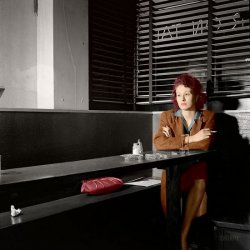
- Shipshop: 1898
- ... not equipped with a mustache trimming room.
Saturday Night! Shipboard entertainment must have been mighty thin if eleven men ... Posted by Dave - 08/05/2010 - 7:22pm -
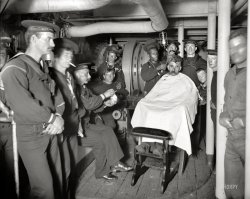
- Rockaway Bungalows: 1910
- ... rented bungalows in the court. Everyone was out every night. The beach was just a few steps away. Fathers came out only for the ... ocean you could see all his cares and worries leave. At night the parents would gather on the porches and play cards, drink a Tom ... Posted by Dave - 08/04/2012 - 3:56am -
![Rockaway Bungalows: 1910 Vacation bungalow colony at Rockaway, Queens, c. 1910. View full size. George Grantham Bain Collection. Note "front yards" of sand decorated with seashells.
Sand in QueensI wonder if any of the buildings are still standing. Since they are tract of small bungalows, I wonder what company supplied that lot for workers to live in.
Sand in...Queens?! Wow.
[Never heard of Rockaway Beach? - Dave]
BungalowsWere these for living or vacation rentals? They sure are cute. Does anyone know how far from the water they were?
Rockaway[Never heard of Rockaway Beach? - Dave]
Well I've heard of Rockaway Beach here in Oregon. :)
Re: BungalowsThe were seasonal at first. More info at the Beachside Bungalow Preservation Association:
By the 1920s, Rockaway Beach was the poor man's Riviera. It had a six-mile long boardwalk lined with amusements, and thousands flocked to the beach every summer weekend. Many families rented tents for the entire season, while those a little more affluent rented small bungalows. The concept of the bungalow in America was well established by this time as they were built for summer communities on both coasts. The plans could be purchased from catalogues and were designed in numerous styles.
This last remaining bungalow colony was built by Richard Bainbridge in the 1920s. The one and a half story houses all have front porches and pitched roofs. The design and style vary from street to street. Some of the bungalows are in a Spanish Revival style of stucco with wood trim and green the roofs, and others are in an English Tudor of brick. Lacking heat, they were closed for the winter months. The lanes leading to the beach have permanent easements for common access.
As development pressures change the Rockaways, this small district has become endangered. But it would be appropriate to preserve and restore this remnant of past summer amusements.
The yards are super.The yards are super. Send the kids down to the beach to bring back sea shells to decorate with! Talk about a family project.
Rockaway BungalowsI'm pretty sure these are not there anymore. In fact Rockaway Beach today is quite run-down. If you take the A Train out there, these must have been between the tracks and the water, where there are now streets with no houses. Only weeds.
Sadly, most of theseSadly, most of these bungalows are gone, as Doug points out above. There are only a few left, and they face demolition by developers who want to turn the Rockaways into yet another bland housing development. These were vacation homes for folks in Manhattan and the other boros, not company houses for factory workers. How close were they to the beach? How does less than a city block sound? In the Rockaways, as at Coney, Manhattan, Brighton, and other New York City beaches, the streets are set up perpendicular to the beach and are only a few blocks long. The last block actually ends at the boardwalk. Across the boardwalk is the beach. The Ramones were from the Rockaways.
Beach 29th streetMy family rented a bungalow on Beach 29th street until I was around 12 years old. As soon as school was over, my parents would pack up a van and off we went until Labor Day. It was the most amazing summers of my life. No locks on doors, showers in the backyard, fireworks Wednesday nights. My parents belonged to a group called FROGS- Far Rockaway Ocean Goers. The Bungalow owners, Mr. and Mrs. Herman, would let my Dad come before the season to fish. The last time I was there was about 36 years ago. It was so sad to see the destruction of these amazing bungalows. Ours was white and green, and all the furniture inside was painted a sticky tacky gray. My Grandma and Nana lived a few blocks up in a rooming house. It was very sad to watch as these homes burned to the ground. Such a day-gone-by era.
Beach 29th StreetHi!
I am very curious exactly where on 29th Street the bungalow was. I lived on 29th just off Seagirt Blvd. It was a year 'round dwelling. The area was VERY crowded during the summer and VERY empty from after Labor Day until Memorial Day.
Do you have any pictures from there? I would love to see them!
Thanks,
Marc
Far Rockaway refugee now living in Bayside, NY
Rockaway BungalowsThere was nothing better than spending the summer in Rockaway. Most of your family members rented bungalows in the court. Everyone was out every night. The beach was just a few steps away. Fathers came out only for the weekends, even if you lived in Queens...
Beach 107 StreetMy aunts, grandmother and uncle would whisk us away to Rockaway the minute school closed for the summer. We would stop at Weiss's for fish and chips, then drive over the old Cross Bay Boulevard bridge and see the top of the roller coaster and the ocean beyond. In a few minutes we would be at our bungelow in Highland Court, the second one in. We thought we had arrived since we had a hot water heater. It was a great place for kids to grow up. Every day my sister and I would open the window with the sun shining down on us. We would get into our bathing suits and run to the beach, riding the waves until we were dragged out by our relatives.
Beach 106 StreetBetween 1951 and 1958 or so I stayed with my good friend Donald Sullivan and his family in bungalows on Beach 106 Street. I don't remember the court name - if it had one. I do seem to remember Highland Court but this was centuries ago and memory may play tricks.
Sand in QueensA similar group of bungalows still exists in the Breezy Point Coop and Roxbury in Queens. Many have been expanded and converted to year round use now, though some are still used only for the season. They refer to Breezy Point and Roxbury as the "Irish Riviera" due to the strong Irish presence.
B. 29th bungalowsI know EXACTLY where you were. My grandmother too had a bungalow, about 5-6 before the boardwalk ramp. They were on the left side, because on the right side was a parking lot or a building (I can't remember it exactly). But up the block was two hotels - the Regency and another one. They were both owned by the same people - Mr. and Mrs. Hecht, german/lithuanian-jewish folks. If you remember, there was a wooden bridge that connected the two buildings, and the courtyard was shared by the two. The showers were both underneath the front of the buildings behind the, lattice and then common showers/bathrooms in the hallways. There was one public phone on each floor and a television on each floor. When my grandmother could no longer stay in the bungalow (either they were sold, torn down or condemned), she went into the Regency Hotel. She was in the basement which was very cool in the summer. They dodn't need air conditioning.
The last party of the season was Mardi Gras. My grandmother, being on the heavy side, loved to wear blackface makeup and put her hair up with a tied kerchief - she was "Aunt Jemima."
I only wish I had a place like 29th street to bring up my children in the summers. We ended up renting cabanas in Atlantic Beach from when they were little, then moved to Atlantic Beach, but retained memberships at the beach club. We can't get the sand out of our shoes!
Belle Harbor's Bungalows I was searching for a picture of Weiss's Restaurant and stumbled across this site. I found one taken before the war, but was hoping to find one more recently, like late 1950s or early 60s. Looking at the group of bungalows, there were similar ones along the beach 2 rows deep at B129th Street in Belle Harbor, Rockaway. They looked very similar to the ones in the pics if memory serves. I was there last year and although they still occupy the same footprint, most have either been completely reconstructed or torn down and replaced with more modern ones. I recall every summer going to the beach and seeking out the "city" kids here for a few weeks. We made lots of new friends every summer. Then there were the bungalows out on RockyPoint/BreezyPoint.
My mother spent her childhood summers, probably right there in that picture. Her parents owned their own bungalow. I have a picture of it from around 1941. Mom's 83 and I'll have to print this off and show it to her.
Maple Court, Beach 28th st.I've been searching for info on Far Rockaway. I've been strolling down memory lane thinking about my wonderful summers there. My family rented, and we stayed for a total of five summers. The last two were in Maple Court, which, I believe, was on beach 26th or 28th Street. Before that we were in B Court and A Court on 28th. I agree with the posters who spoke of these summers as paradise! I felt truly free there. And yes, nothing was locked up. There was no schedule to keep. Just pure fun. My last summer there was in 1969. I remember this because of the moon landing. We returned home from the fireworks display on the beach and watched it on TV. My grandparents owned a fruit store on the main street, and they stayed at a wonderful hotel called the Manor. My happiest memories from my childhood are from Far Rockaway.
Maple Court bungalowMy family purchased a bungalow at 29 Maple Court in 1969 when I was 9 years old. I too had the greatest memories there. We took so much for granted thinking everyone lived as we did. Now I realize how lucky we were back then. Being able to stroll down the street to the boardwalk, watching the fireworks Wednesday nights, and winning prizes at the arcade games are fond memories. Do you remember the pizza shop on the corner? Because the bungalows were so small and cozy, to this day I prefer smaller spaces. Thanks for letting me relive those memories for just a short time.
The EmbassyWe stayed in the Embassy on 29th Street (right next to the ramp to the beach). Many of my friends were in the bungalow courts between 28th and 29th. We stopped going in 1967 but those were the best times -- those summers were magical. My husband and I went back in 1998. There is a school where the Embassy used to be and nothing much else. I went down to the beach and I cried.
Who were your grandparents?Carolyn, my parents owned the Manor at 2400 Seagirt Blvd (beach 24st). My last summer on Rockaway Beach was 1967 just before I entered the Army. My parents and I moved to South Florida shortly there after. I was 6 miles from the DMZ in Vietnam when we landed on the moon.
Fruit storeCarolyn, if memory serves (pretty fuzzy by now), your grandparents were the Lebowitzes. The fruit store was on Edgemere Avenue just off Beach 24 next to Willy's Market.
If I am right, I am amazed.
The EmbassyMy family had a bungalow on B29th Street on "the ramp" from the 1950s until around 1970.
I got thrown out of the Embassy by the owner because we didn't live there. I bought ice cream at the candy store under the porch of the hotel.
I saw the school, it was a bummer. I remember Lenny's, skee ball, Jerry's knishes, Sally & Larry's pizza, movies on the boardwalk, Dugan the baker, softball games, basketball in the parking lot. I used to sell lemonade to the ball players on hot days. Memories ...
I remember a girl named Cherie or Sherry. She had a boyfriend, Arnie. I used to hang out with Arnie's brother Marvin.
lmc2222@aol.com
Far RockawayI also have childhood reminiscences of Far Rockaway. My family lived in a small bungalow rented for a group of Russians in 1970s (yep, I am Russian, living in Moscow now). I was 3 or 4 years old at that time, so I do not remember much. What I know is that these are one of the brightest memories of my early childhood. My pa said the house was really small. I do not know what street it was on, or if it still exists.
What matters are the snapshots of my memory: me sitting on a porch on a rocking chair, and the arches of the porches, of the same form and shape, go all the way down to the ocean. Me playing in sand, building garages for toy trucks, with other children running from waves that seemed - wow - so really huge. And above all and around all, the salty smell of Atlantic, which is different from any other seaside smell.
Great pity the place is devastated today. Hope that everyone who has ever had good times in Far Rock keeps his own memory snapshots of the place, where it looks as it really should.
Fruit StorePeter, you have an incredible memory! My grandparents were the Leibowitzes. That's such a specific memory. Did you know them personally? I would love to hear about any memories you have of them or the store. Were you a child at the time?
The EmbassyCheri, I can understand your crying. I went back many years ago and was also upset to see the area so demolished. At that time, it seemed the only bungalow left standing belonged to a lady we were all so afraid of on Maple court. She seemed to hate kids (probably we just annoyed her mercilessly!). But going back as an adult, I saw her situation quite differently. The bungalow was all she had, and so she stayed there while everything around her seemed to be destroyed.
Maple Court BungalowLillian, we must have known each other since we were there at the same time, and we were around the same age. I was in the first bungalow on the right, facing the main street. You might remember the pile of junk in front of the house (left by the owner, which we were waiting for them to take away!) Where in the court were you? I remember a girl named Elena, and a boy everybody had a crush on named Eddie.
The ManorWow... your parents owned the Manor! What an interesting and exciting experience that must have been. If I recall correctly, there were an eccentric bunch of characters staying there.
Carolyn! What a great happening!Hi Carolyn,
Glad you found me on Facebook. Your ability to put me together with my earlier Shorpy post was remarkable, so I am posting this for the benefit of "Shorpy page readers."
Your recollections and mine from the 1960's certainly attest to how great having the internet and pages like Shorpy's are. (Shorpy..thank you!) The fact that I remembered your grandparents is somewhat unique cause I can't remember anyone else's grandparents from way back then, other then mine. I must have really liked them and was destined to cross your path again. I remember sitting and talking with them on porch of the Manor in one of those green rocking chairs. They were "grandparent" types, had a European accent like most grandparents back then, and easy to be comfortable with.
Just to put things into focus, I am now 63. That was back when I was 16 or 17 and younger, but your grandparents returned to the Manor for quite a few summers in the 1960s. How could I have remembered your grandparents' name? I too am amazed and flabbergasted.
Memories of Far RockawayYes, this website is truly wonderful for allowing us to stroll down memory lane and recall the sights, smells and feel of Far Rockaway... and what an extra treat for me to find someone who actually knew my grandparents. Thank you Shorpy's for allowing us this exchange of information and memories... and thank you Peter for your kindness and your very sharp memory!
Far RockawayMy sister directed me to this site. We stayed in the Jefferson Hotel, right between Beach 29th and 30th, next to the Frontenac. My good friend Faye's grandparents, the Kratkas, owned the Embassy and both Faye and I worked the concession stand which her parents ran.
The memories of the boardwalk are still strong. Not only did we have the luxury of a fantastic beach at our doorstep, we also had nighttime fun. Cruising up and down the boardwalk -- eating pizza at Sally & Larry's, or Takee Cup (originally called Tuckee Cup until the owners got disgusted of painting out the alternate name it always received over the winter months) and listening to Eddie, with his ever-present songbook, sing requests. All added up to good, clean fun.
I left in 1968, went back from time to time, but haven't been back in years. Unfortunately, you can see enough from Google Earth.
My two auntsMy father's two aunts had a bungalow in Rockaway Beach in the late 50's early 60's. It had flowered wallpaper and a musty smell, but it was the most interesting home I have ever been in. I was allowed to leave and explore without my mother's glare. I cannot tell you what food we ate there. I have no memory of meals which is odd. I do remember being bitten by my aunt's dog, which scared me for a long time. I think their names were Bernice and Ruth Cohan. If you have any thing to share please do.
thanks, Mary Donaldson
neversynvr@aol.com
Twin HousesThe houses with the bridge were known as "the twin houses", possibly the Claremore & Edgewater, both owned by the Hechts. I spent the happiest summers of my life there!
Like Cheri, I've wanted to return, but haven't as I know how sad it would be. Better to revisit in memory, sometimes in dreams.
I probably know Cheri (from Arnie & the Joey days) and Les rings a bell, as does singing Eddie...
Marcy
Sand in my shoes on Beach 107thMy mother's family went to Beach 107th in the summers of 1917 through 1929. After the Depression hit they couldn't afford it. I still have photos of that period.
In 1951 our family went down to the Rockaways and rented a bungalow for the season. The courts I remember were Almeida and Holmenhurst.
My dad came only for the weekends, arriving Friday evening. The first thing he did was put on his trunks and head for the beach with me. When he hit the ocean you could see all his cares and worries leave. At night the parents would gather on the porches and play cards, drink a Tom Collins or have a beer and just have a good time.
As a 10-year-old I wondered what was so much fun doing this every weekend. It occurred to me many years ago that boy, did they have it made. Sitting on a porch with a nice summer drink, a cool ocean breeze along with good friends to talk with and play cards with. Life was so laid-back and simple then.
Does anyone remember the doughnut shop Brindle's or the bakery Dudie's? What about Nat's Ice cream shop, where you could get a walk-away sundae. Bill's Deli had the best salads and cold cuts.
Wonderful summers that will always keep me warm in the winters of my aging mind.
Beach 28th Street & A B and C CourtsI too remember the pizzaria on the corner of Beach 28th street. I remember my friends Randy, Shmealy, Risa, Brenda and Jody. I don't remember Shmealy's given name, but I remember he was hyperactive and a lot of fun. Made up a song from the commercials of the time for Halo Shampoo. "Halo Sham-poo poo, Ha-a-lo! Jodi's mom didn't want me hanging around Jody because I blinked my eyes too much. Oh well. HEY: Jody from Beach 29th street who wrote a post here on 11/12/2007 - I wonder if you're the Jody I remember!? I hung around with Risa a lot. I still have a photo of us and my dog Suzie on the porch of my Bungalow. I once disappeared into the Courts of Beach 28th street while walking my dog. I ended up talking to a boy for 2 hours, not knowing my parents had called the police and had an all-out search for me. My father finally found me. I was the talk of the town that day! I hope someone remembers these people or IS one of these people, or remembers the lost girl incident and would like to contact me at orangechickens2@aol.com. It would be wonderful to hear from you!!
Anyone remember dogball?My dad wrote about playing dogball on the beach at 110th Street on his blog at willhoppe.com.
I'm going to show him all of your comments later tonight.
The BungalowsI was born in Far Rockaway in 1942. I lived there for 16 summers. My dad owned a small grocery on B 28th street. It was the best time of my life. Maple Court faced 28th. To me it was a very exotic place. The renters/owners vacationed there, my dad was a workman. We lived in roominghouses with a bath on the floor. One year I begged my dad to live in Maple Court and we got a small apartment in the back of a bungalow there. The bungalows were the BEST.
Rockaway native from HammelsBorn in Rockaway in 1941 at Rockway Beach Hospital. Went to PS 44, JHS 198, Class of '59 from Far Rock. Worked as a locker boy at Roche's Beach Club in Far Rockaway. For two summers I worked in Rockaway Playland. I lived on 90th, where my parents rented out the bungalow in the back of our house every summer. My father at the end of his years as a waiter worked in Weiss's dining room, and the Breakers restaurant on 116th Street.
I met my wife in 1965 at McNulty's on 108th Street. She was from Woodhaven and Breezy Point. We got married in '68. I am writing this on the back deck as we are still enjoying the summer weather here at Breezy. We both still have sand in our shoes.
Our 1940s summersA group of Bronx families spent the summers of the early '40s in a few bungalows. Sundays the working fathers would appear for a community breakfast. We celebrated V-J Day with a parade on the boardwalk. Takee Cup was a part of our diet. A noodle cup to be eaten after the chow mein was devoured. The ultimate hand held food treat.
Beach 25th StreetI grew up in Far Rockaway in the 1960s and 70s. We lived in the Bronx and rented every summer on Beach 32nd Street (now two big apartment buildings -- Seaview Towers). When I was 9 or 10, we moved to Beach 25th year-round. The summers were great -- we didn't wear shoes most of the time.
Every Friday night, "Bingo Al" held a game in the court behind the bungalows, between 25th and 26th. One summmer he had a "Chinese auction" and dressed up in an oriental robe and Fu Manchu mustache and beard.
Many of the residents got seltzer water delivered in bottles at their back porch. They would gather in the evenings out in front of the bungalows and talk and joke. I would lie in my bed, with my ear pressed against the window screen, trying to listen, and also trying to stay cool -- no air conditioning.
Sol "The Cantor" Gerb would play his little electric organ as people sipped their drinks, chatted or played cards. It was like a different world from the rest of New York.
I read where one commenter talked about the bungalows rented for the Russians. This was on Beach 24th Street. They worked at the United Nations and rented a block of bungalows. Every Monday morning passenger vans would show up to take them to work at the UN. We played with the Russian kids. They were a good bunch. I stayed over at one of their bungalows and we had crepes for breakfast. I had no idea what crepes were! I learned to play chess, as the Russians were crazy about it. I recall one time when members of the Jewish Defense League blew up a small BMW belonging to one of the Russians. The news came out and I was in the background, behind the reporter. A sad time for Far Rockaway.
One of the amazing things was the backgrounds of the bungalow residents -- former concentration camp prisoners, Russians, Irish, Jews, some Italians and Greeks, but we all got along so well. A great place to grow up!
At the FrontenacMy family spent summers at the Frontenac from the late 40s until 1957. When I describe it to my daughter, I have to confess it was really more like a boardinghouse. My mother, father and I shared a room that was also the kitchen. Bathroom on the floor, showers were out back for when you came back from the beach. It was great community. Juke box for dancing, card room for gin and mah jongg and the television on the porch.
I loved Jerry's cherry cheese knishes. I remember the movie theater on the boardwalk in the 30's (it could barely be called indoors)
I bought the News and Mirror off the delivery trucks for 2 or 3 cents and sold them for a nickel.
My parents would pay the guy who ran the first aid station under the boardwalk to hold our beach chairs overnight so we wouldn't have to "schlep" them back and forth.
We played softball on the blacktop parking lot on 29th street right off the boardwalk.
My wife, who I did not know then, stayed with a friend's family in a bungalow on 29th street. I think her best memory was playing Fascination.
Best summers everI used to stay at my grandmother's bungalow on B 28th st. in the mid to late 60s. Those were the very best summers ever! Walking just a few yards to the boardwalk and beach, pizza from the store on the corner, hanging with Howie and the crowd there. Playing Fascination for a dime, huge french fries in those cone cups.
If anyone knows the whereabouts of Howie Young I'd love to get in touch with him. My email is belongtoyou@hotmail.com
Hugh McNulty Hotel, Rockaway BeachI am trying to learn about Hugh McNulty's Hotel. I am not sure what street it was on, but there was also a bar in it. Hugh was my mum's uncle and her father came to stay with him and work for him. The time period may have been 1924-1930. I know the hotel was still in operation in 1953, as my grandmother visited him at that time. Any help is appreciated. libtech50@comcast.net
Edgemere memoriesMy family lived many places in the Edgemere section of Far Rockaway (I don't know the exact boundaries of Edgemere, if there were any), but my memories centered on Beach 48th Way and Beach 48th Street. Fantastic place to spend the summers and escape the hell of the South Bronx. I had wonderful Jewish friends and I worried that they would go to hell because they weren't Catholic. Now I laugh as such perverted theology, but back then it was serious stuff.
I loved the beach, the ocean, the starts, the jetties, playing every group game known to humans, going over the the "bay side" to play softball with the "project people" -- those who lived beyond the marshes and spent the winter there.
No doubt about it, the best part of my childhood was Rockaway. Too bad it was taken away from us and to my knowledge, still is just a bunch of sand with no houses where we used to live, right near the boardwalk.
Beach 48th Way, RockawayIn the early 1960s there were two brothers that were lifeguards when my family was there, Dennis and Tom Fulton. Anyone remember them? Also there was a man named Warren who would feed pigeons at the end of the block every day. My parents would rent a bungalow in the summer months to get us out of Brooklyn for awhile. Great memories.
Rockaway, a kid's dreamI remember growing up in Rockaway. We had two boarding houses on Beach 114th Street. When my mom was a kid, Carroll O'Connor, his mom and brother Frank stayed with them. He returned to see my parents back in the mid-eighties and I received one of his last e-mails before he died. I worked my way bartending at Fitzgerald's on Beach 108th and Sullivan's on Beach 116th (1967-1970). You could leave the house at 7 years old, walk to the beach without crossing the street and never had to worry one bit. The neighbors looked out for everone's children. Great memories and thanks to Shorpy for an incredible site. Brilliant job!
Cohen's CourtThe picture above is very much how I remember the bungalow court where my parents rented in the summers of the early 1950s. I think my mom said it was Cohen's Court. Ours was at the end of the court on the left. I don't remember too much, I was really little. But I think there was a center row of garden where parents hid treats for us to hunt. I remember a corner candy store we kids could walk to and my mom confiscating a tube of plastic bubbles I bought. I guess she thought the fumes would get me high or something. There was a little girl across the court who would stand on her porch in a towel and flash us once in a while. And I have a memory of being on the beach with my parents, I in the sand and my mom in a beach chair, and my dad taking me into the water. I went back with my parents in the early 60s because they were thinking about renting it again. But it was so musty and dirty and ramshackle that they decided against it. I had a girl friend with me and I have to say I was embarrassed about the way the place looked and smelled. Too bad, that bungalow was a great summer getaway for a working class family from Brooklyn.
Elisa on B 29thWas your grandma named Bessie? I lived in the Claremar, one of the twin houses, and I remember her. Did you have a brother too? My sister, parents, grandmother and baby brother and I all lived in two rooms in the basement. I remember Crazy Eddie and his huge black book of songs. Tina and Elise ... Elliot ... Donna ... Jackie ... smiling in memory!
Palace HotelThe last place my family stayed at for quite a few years was the Palace Hotel on Beach 30th Street right near the boardwalk. Those were the days my friend. All the arcades and food places on the boardwalk, Cinderella Playland for the little kiddies, the Good Humor man , Ralph was his name.
Life was simple. No internet, cell phones or video games yet we had great times and wonderful memories. We played board games and cards and rode our bikes. The guys played baseball in the parking lot adjacent to the Palace Hotel.
The team was a mix of every race and ethnicity and everyone managed to get along and looked forward to playing together the next Summer. The beach was the best. Dads could go to work and come back every day rather than only on weekends as they do in the Catskills. Such a shame that this no longer exists. The last summer I went there for a few weekends was in 1976.
The JeffersonMy grandparents rented a place in the Jefferson for many years. I have great memories of the place, the back stair cases, the porch, and the beach just a short walk away. Does anyone have relatives who stayed there?
Rockaway summersI spent virtually every summer till the age of 22 in Rockaway. We stayed on Beach 49th till they knocked them down, then kept moving to the 20's.
Best time of my life. My family was unique -- Italians in the Jewish neighborhood and we came in from Jersey! My mom grew up in Brooklyn and her family started coming in the '40s!
Wish I could connect with friends from back then. If I sound familiar please let me know. You would be in your mid to late 50s now.
Rockaway Beach Bungalows on PBSI received a message, last night, from my girlfriend who stated that "The Bungalows of Rockaway" was on PBS @ 8PM. I started watching at 8:30 and to my surprise I could not stop watching.
I was born at Rockaway Beach Hospital and I am a lifer. I never lived in a Bungalow but I have always wanted to purchase one. I was taken aback by the fact that there were at least 6,000 bungalows and now there are approximately 300 (big difference).
I also found out in this documentary that there is hope that the bungalows can be landmarked and I hope that it happens. The bungalows are a unique attraction to this area and I hope that the 300 remaining can be preserved.
Elisa on B. 29th Street - the hotelsTo Anonymous Tipster on Fri, 08/13/2010 - 3:15am - YES! My grandmother was Bessie. I do remember your family - your grandmother, parents and the little ones. Your mom wore glasses and had blonde hair. She always wore her hair pulled back and up on her head, curlers in the evening.
Also, Harry and Dottie lived in a large room in the corner of the basement of the hotel.
I have 3 brothers and one sister. My Aunt Rose and Uncle Leo used to come to the hotel as well to visit with Grandma Bessie.
Please e-mail me @ medmalnursing@msn.com
Sally's Pizza and the Lemon & Orange Ice StandI spent the best summers of my life on Beach 28th Street. Coming from a Bronx apartment, it felt like our own private house. Our own family doctor came out to Rockaway every summer and stayed on Beach 24th Street. I now wonder what happened to his patients during July and August. How come nobody has mentioned Sally's pizza, on the boardwalk around 32nd Street? You couldn't forget Sally-- with her bleached blond hair, tight pants, and backless highheels. Near Sally's was the fresh lemon and orange ice stand with the fruit stacked against the wall. The ices even contained pits. No artificial coloring or corn syrup in those ices.
Grandmother's bungalowsMy grandmother owned 10 bungalows on the beach on 35th Street from the 1930s thru the 1950s. They were the ones nearest the water. I loved going to help her get them ready each spring and clean them up each fall. Playing on that wonderful empty beach at those times of year with no one else in sight.
We lived in Far Rockaway at 856 Central Ave., so going to the bungalows was not a long trip. Great memories.
Mom's RivieraMy mother loved Rockaway so much that we called it "Mother's Riviera." She couldn't have cared less about the beautiful beaches across the ocean in France or Italy, for Rockaway Beach was her greatest joy. We spent many summers in a bungalow court on 109th Street and my grandmother and her sisters also spent their youthful summer days in Rockaway Beach. So our family goes back generations loving Rockaway.
Every Memorial Day the court always had a party to celebrate the beginning of summer and the courtyard inhabitants were usually Irish. The courtyard came alive with Irish songs and jigs and reels. Of course, the people of the courtyard always chipped in for a big keg of beer. It was repeated on Labor Day as we all said our goodbyes to our neighbors and to our beloved Rockaway Beach.
Saturday nights in Rockaway were spent at the closest Irish bar and some nights the local boys slept under the boardwalk after having a wild time. They always managed to get themselves together for Sunday Mass or otherwise they would get holy hell from their families.
Sands of TimeI spent every summer in the Rockaway bungalows from the fifties until the mid eighties when we were forced to leave because of the deteriorating situation. I was a child on Beach 49th and remember George's candy store where you could get a walkaway sundae for 50 cents.
Sue, I remember the Fulton brothers, who were lifeguards. Handsome devils, had a crush on Tom when I was 14. Times were safe. There were a thousand kids to play with. We went from 49th, 40th 39th, 38th, 26th and finally 25th Street with my own kids trying to hold on to that wonderful way of life. Unfortunately it disappeared.
Some of the best days of our liveswere spent on Beach 25th. When I was 12 (1936) until I was 17, we stayed every summer at my grandmother's at Beach 66th Street. Those were glorious days on the beach. The boardwalk at night was wonderful, too. We played pinball, and games of skill for 5 cents to collect prizes. Bottled soda and ice cream were 5 cents then, too. We used to run up to the boardwalk to eat the delicious knishes. My summers at Far Rockaway were the most unforgettable of my growing up. Tuna fish and bologna sandwiches on a roll never tasted as good as it did at the waterfront.
In 1961, when I was married with children, we rented a bungalow on Beach 25th and loved it! It was a rainy summer and we spent a lot of time in Far Rockaway shopping, eating and going to the movies. Every sunny day, however, we quickly rushed to the beach to enjoy it with family and friends.
The Jefferson, Beach 30thI stayed with Grandma and Grandpa every summer for years in a small room at ground level. Grandpa would take me to the beach in the morning, then off to the stores on 24th Street. The back patio was for dancing on Saturday night and the concession inside had bingo. The porch! As I grew up to teenager, I met Ronnie Schenkman and family on the second or third floor (used the back staircase). I don't remember where Eleanor stayed. Crazy Eddie and his songs. Hal and his girl of the night. Warm nights and days. Very sexy!
As a working girl I still took the RR to Far Rockaway, then the bus to Edgemere. Took my children to visit Grandma when it was becoming sad looking. Then went to the area years later and found a burnt shell with a wicked fence surrounding it. Took pics and had a good cry. We are all lucky that we were able to experience the wonderful warm sun and sultry nights.
Belle Harbor BungalowsI think the two rows of Belle Harbor bungalows on Beach 129th to which another person referred were probably the Ocean Promenade Apartments. I have very happy memories of living there in the mid-i950s in the winter.
Beach at 37th streetWhat a trip to see all of the these comments. I grew up and lived year round on Beach 37th until 1950, when we moved to Bayside. Takee Cup was a treat as well as the movie theater on the boardwalk, Italian ices and of course the arcade. For a penny you could get great photos of famous cowboys and movie stars.
Rockaway in 1958My family spent the summer in Rockaway in 1958. Most of our friends were in the court, but we were outside it on the main street. I don't remember the street, but I suspect it was around Beach 45th, as the El was right on the corner.
We had a bungalow with a porch. I was climbing on the outside of it, fell when I saw a neighbor's dog that I wanted to play with, and broke my wrist on broken concrete. Today, one would sue the owner. Back then, we just made do.
Later that same summer, I ran across the street to get Italian ices from the local candy store, but looked the wrong way crossing the one-way street and almost got hit by a car. I didn't think that much of it, but the woman driving was hysterical.
I also remember a movie theatre on the Boardwalk. In those days, an 8-year-old (me) could feel safe walking the boardwalk without an adult present. The back of the theater opened up at night so you could sit outside. I saw "The Colossus of New York" there, an incredibly bad "monster" movie.
Most of the bungalows in the Rockaways were destroyed by Hurricane Donna in 1960. So-called "urban renewal" took care of the rest. Now some sections of the Rockaways, especially those facing the ocean, are filled with expensive new condos.
The Jefferson 1950s I stayed at the Jefferson in the 1950s. It was far far away from the Bronx.
Our father worked two, sometimes three jobs, so my brother and I could escape the Bronx and spend each summer --the whole summer-- in Rockaway. Dad took the train to work every day. We turned brown by July 4th; skinny brown kids always running, scheming, cunningly evading the watchful eyes of Jewish mothers.
We played softball in the parking lot by the beach in the early mornings before the cars showed up. We played kick the can in the street, ring-o-lerio (sp?), off the stoop. And then there were the long long days on the beach, hopping on hot sand from blanket to shore, waiting the magic 45 minutes to go in the water after eating lim and sandy salami sandwiches, early versions of body-surfing, acting like we couldn't hear our mothers calling that it was time to come in from the water. Crawling into the cool dark sand under the boardwalk.
Some kid named Howie always had a piece of fruit in hand, juice dribbling down his chin. And then there was a kid whose own family called him "Fat Jackie" -- at least that's how I remember it. Once in a while we were treated to Takee cups or lemon Italian ices, and chocolate egg creams. Always sneaking off with so much watermelon that your belly ached, and sand -- always sand -- in your bed.
Jumping off the wooden steps to the beach, higher and higher, until you dared to jump from the railings along the boardwalk. I think it was Friday nights we would go to the boardwalk to watch the fireworks display from Playland. Flying kites over the surf when the weather cooled, and sneaking out to the Boardwalk to watch, awestruck, huge summer storms -- was it hurricane Carol?
Evenings with men playing pinochle, women playing mah jongg. Ping Pong, hide & seek around the Jefferson. Costume parties with fat hairy men wearing grass skirts and coconut shell brassieres, and mothers with painted mustaches and sideburns, wearing huge hipster hats, chewing cold cigars.
Then, dreaded September, back to school and insanely diving under your desk to practice for the upcoming atomic war, or wondering whether you were one of the kids who got the fake Polio vaccine. But somehow, during those summers at the Jefferson, there was nothing to fear. Nothing at all.
Beach 45thDoes anyone remember Scott Whitehill or Laird Whitehill? If so, please e-mail me at scott@scottwhitehill.com
Moe's Grocery Store on Beach 28thBarbara posted a comment earlier about her dad owning a grocery store on Beach 28th Street. The name of the grocery store was Moe's, and they carried lots of things for a small store. I lived in bungalows on Beach 28th and Beach 29th Street. These were the most memorable times of my life. I only wish that I could go back and see and relive these wonderful times.
Beach 49thMy family and many of my relatives owned bungalows on Beach 49th and Beach 48th Street. We spent every summer there until the city condemned the properties. My father brought one of the first surfboards there in the early 60s. I have many fond memories of the beach and the friends I made.
(The Gallery, G.G. Bain, NYC, Travel & Vacation)](https://www.shorpy.com/files/images/01983u1.thumbnail.jpg)
- Barefoot Scholars: 1940
- ... size.
Somebody didn't get enough sleep last night Or maybe the teacher's just boring.
What's the beef? Dead ... Posted by Dave - 09/14/2019 - 5:58pm -
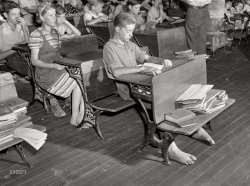
- Dacotah II: 1940
- ... Retro Rides Soooooo many PT Cruisers.
Beautiful at night With the neon signs and those spectacular five globe streetlights. ... Posted by Dave - 12/07/2019 - 12:32am -
![Dacotah II: 1940 October 1940. "Grand Forks, North Dakota." A scene last glimpsed here in 35mm. Medium format negative by John Vachon for the Resettlement Administration. View full size.
Retro RidesSoooooo many PT Cruisers.
Beautiful at night With the neon signs and those spectacular five globe streetlights. What nostalgia.
Wired correctlyThe globe lights are very nice. Notice that the power lines are buried? Good forward thinking.
Camera swap sequenceIn case anyone ever needed to know, Mr. Vachon took the 35mm version before the medium format version.
[Was he in his pajamas? - Dave]
(The Gallery, Cars, Trucks, Buses, John Vachon, Small Towns)](https://www.shorpy.com/files/images/SHORPY-8c18013a.thumbnail.jpg)
- Camera? What Camera?
- ... appears frequently as Homer Simpson's family pet.
Night and Day Her dog looks very different from the dog visible in the ... Posted by Dave - 09/11/2011 - 9:13pm -
![Camera? What Camera? "Miss Mary E. Patton. Dog Show, 1915." One of many images from the Washington dog show of 1915 showing fancy canines and their even fancier owners, all of them female for some reason. Harris & Ewing Collection glass negative. View full size.
Holy dog-bangs!That pooch needs a seeing-eye woman!
...and I bet that an English...and I bet that an English sheepdog at a dog show today would have its own hairdresser! This one looks a little windblown.
WhippetsThe dogs in the background look like whippets -- much smaller than greyhounds. The one in front in an Old English Sheepdog. Believe it or not, breeds may change a lot over a century. For example, bull terriers did not used to have their egg-shaped head.
Bearded CollieMrs. Patton is showing a bearded collie. If you have property that's the breed to have -- they are majestic. The doorway dog does have haunches like a whippet.
There's more, you say?You say there are many images from this dog show? Pleasepleaseplease say you'll be posting them, too.
[Okay. "You'll be posting them, too"! - Dave]
DogsAfter looking through hundreds of Shorpy's pictures and seeing how much has changed over the last 100-150 years, it's funny how a 100 year-old dog looks pretty much the same as a dog today!
Could it be?That streamlined dog in the doorway bears a striking resemblance to Santa's Little Helper, the retired racing greyhound that appears frequently as Homer Simpson's family pet.
Night and DayHer dog looks very different from the dog visible in the background!
(The Gallery, D.C., Dogs, Harris + Ewing)](https://www.shorpy.com/files/images/05632a_0.thumbnail.jpg)























